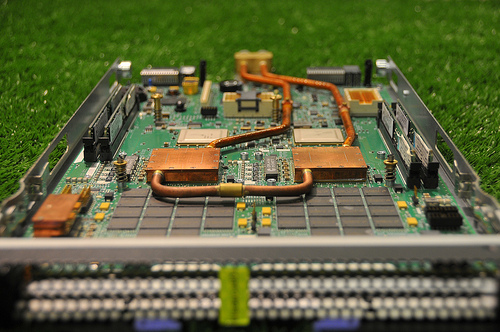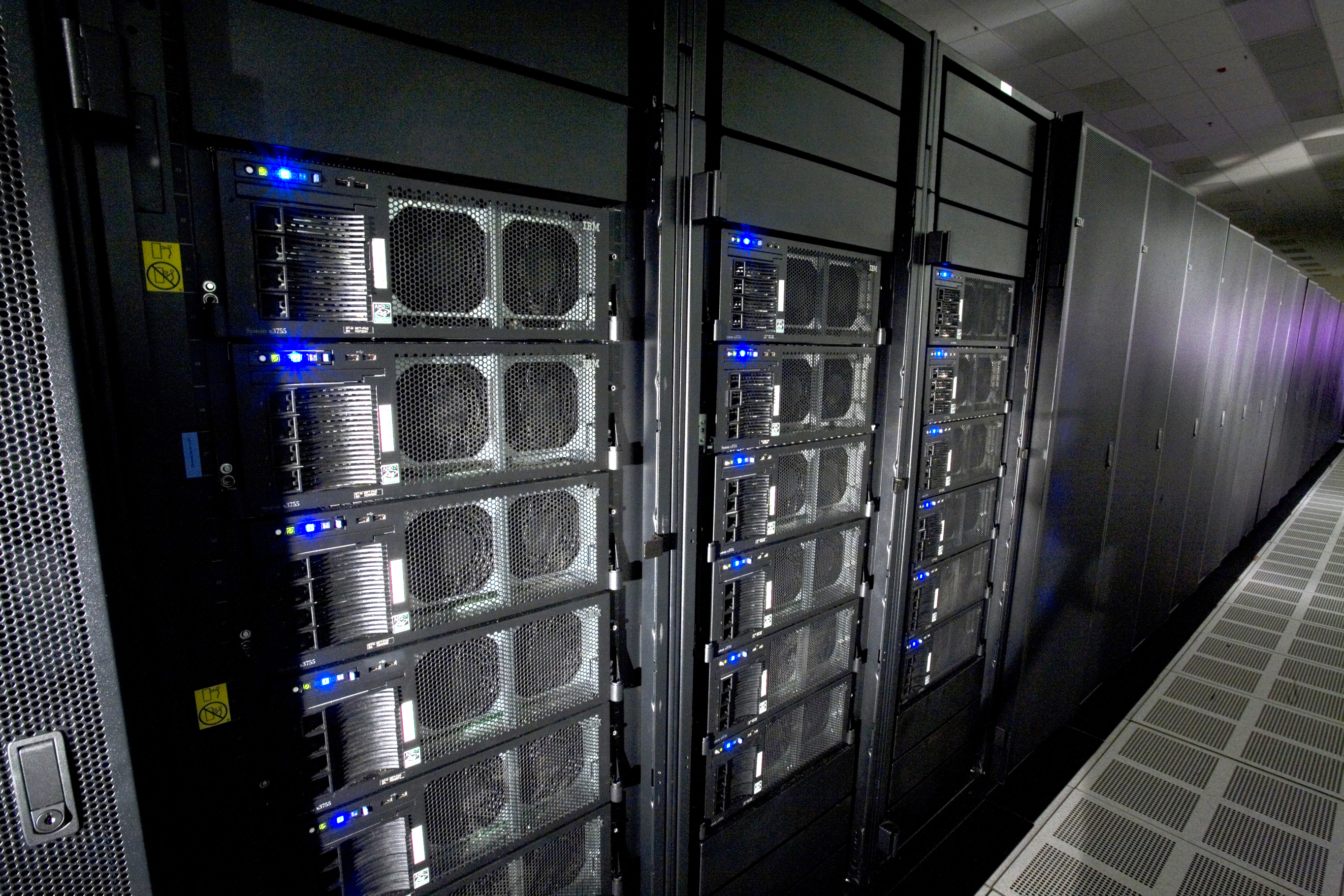|
SuperMUC
SuperMUC was a supercomputer of the Leibniz-Rechenzentrum, Leibniz Supercomputing Centre (LRZ) of the Bavarian Academy of Sciences and Humanities, Bavarian Academy of Sciences. It was housed in the LRZ's data centre in Garching near Munich. It was decommissioned in January 2020, having been superseded by the more powerful SuperMUC-NG. History SuperMUC (the suffix 'MUC' alludes to the IATA code of Munich Airport, Munich's airport) is operated by the Leibniz Supercomputing Centre, a European centre for supercomputing. In order to house its hardware, the infrastructure space of the Leibniz Supercomputing Centre was more than doubled in 2012. SuperMUC was the fastest European supercomputer when it entered operation in the summer of 2012 and in 2015 was ranked No. 20 in the Top500 list of the world's fastest supercomputers. SuperMUC serves European researchers of many fields, including medicine, astrophysics, quantum chromodynamics, computational fluid dynamics, computational che ... [...More Info...] [...Related Items...] OR: [Wikipedia] [Google] [Baidu] |
Leibniz-Rechenzentrum
The Leibniz Supercomputing Centre (LRZ) () is a supercomputing centre on the Campus Garching near Munich, operated by the Bavarian Academy of Sciences and Humanities. Among other IT services, it provides supercomputer resources for research and access to the (MWN); it is connected to the Deutsches Forschungsnetz with a 24 Gbit/s link. The centre is named after Gottfried Wilhelm Leibniz. It was founded in 1962 by Hans Piloty and Robert Sauer as part of the Bavarian Academy of Sciences and Humanities and the host for several world leading supercomputers (HLRB, HLRB-II, SuperMUC). SuperMUC The Leibniz Supercomputing Centre operated SuperMUC, which was the fastest European supercomputer when it entered operation in 2012 and was ranked #9 in the TOP500 The TOP500 project ranks and details the 500 most powerful non-distributed computing, distributed computer systems in the world. The project was started in 1993 and publishes an updated list of the supercomputers twice a ... [...More Info...] [...Related Items...] OR: [Wikipedia] [Google] [Baidu] |
Supercomputing In Europe
Several centers for supercomputing exist across Europe, and distributed access to them is coordinated by European initiatives to facilitate high-performance computing. One such initiative, the HPC Europa project, fits within the Distributed European Infrastructure for Supercomputing Applications (DEISA), which was formed in 2002 as a consortium of eleven supercomputing centers from seven European countries. Operating within the CORDIS framework, HPC Europa aims to provide access to supercomputers across Europe. According to the TOP500 list of November 2024, Italy's HPC6 is the fastest European supercomputer. In June 2011, France's Tera 100 was certified the fastest supercomputer in Europe, and ranked 9th in the world at the time (has now dropped off the list). It was the first petascale supercomputer designed and built in Europe. There are several efforts to coordinate European leadership in high-performance computing. The ETP4HPC Strategic Research Agenda (SRA) outlines a ... [...More Info...] [...Related Items...] OR: [Wikipedia] [Google] [Baidu] |
Aquasar
Aquasar is a supercomputer (a high-performance computer) prototype created by IBM Labs in collaboration with ETH Zurich in Zürich, Switzerland and ETH Lausanne in Lausanne, Switzerland. While most supercomputers use air as their coolant of choice, the Aquasar uses hot water to achieve its great computing efficiency. Along with using hot water as the main coolant, an air-cooled section is also included to be used to compare the cooling efficiency of both coolants. The comparison could later be used to help improve the hot water coolant's performance. The research program was first termed to be: "Direct use of waste heat from liquid-cooled supercomputers: the path to energy saving, emission-high performance computers and data centers." The waste heat produced by the cooling system is able to be recycled back in the building's heating system, potentially saving money. Beginning in 2009, the three-year collaborative project was introduced and developed in the interest of saving energ ... [...More Info...] [...Related Items...] OR: [Wikipedia] [Google] [Baidu] |
IBM System X
System x is a line of x86 servers produced by IBM, and later by Lenovo, as a sub-brand of IBM's ''System'' brand, alongside IBM Power Systems, IBM System z and IBM System Storage. In addition, IBM System x was the main component of the IBM System Cluster 1350 solution. In January 2014, IBM announced the sale of its x86 server business to Lenovo for $2.3 billion, in a sale completed October 1, 2014. History Starting out with the ''PS/2 Server'', then the ''IBM PC Server'', rebranded ''Netfinity'', then ''eServer xSeries'' and finally System x, these servers are distinguished by being based on off-the-shelf x86 CPUs; IBM positioned them as their "low end" or "entry" offering compared to their POWER and Mainframe products. Previously IBM servers based on AMD Opteron CPUs did not share the ''xSeries'' brand; instead they fell directly under the ''e''Server umbrella. However, later AMD Opteron-based servers did fall under the System x brand. Predecessors IBM PS/2 Server * IBM ... [...More Info...] [...Related Items...] OR: [Wikipedia] [Google] [Baidu] |
Intel Xeon
Xeon (; ) is a brand of x86 microprocessors designed, manufactured, and marketed by Intel, targeted at the non-consumer workstation, server, and embedded markets. It was introduced in June 1998. Xeon processors are based on the same architecture as regular desktop-grade CPUs, but have advanced features such as support for error correction code (ECC) memory, higher core counts, more PCI Express lanes, support for larger amounts of RAM, larger cache memory and extra provision for enterprise-grade reliability, availability and serviceability (RAS) features responsible for handling hardware exceptions through the Machine Check Architecture (MCA). They are often capable of safely continuing execution where a normal processor cannot due to these extra RAS features, depending on the type and severity of the machine-check exception (MCE). Some also support multi-socket systems with two, four, or eight sockets through use of the Ultra Path Interconnect (UPI) bus, which replaced ... [...More Info...] [...Related Items...] OR: [Wikipedia] [Google] [Baidu] |
Petabyte
The byte is a unit of digital information that most commonly consists of eight bits. Historically, the byte was the number of bits used to encode a single character of text in a computer and for this reason it is the smallest addressable unit of memory in many computer architectures. To disambiguate arbitrarily sized bytes from the common 8-bit definition, network protocol documents such as the Internet Protocol () refer to an 8-bit byte as an octet. Those bits in an octet are usually counted with numbering from 0 to 7 or 7 to 0 depending on the bit endianness. The size of the byte has historically been hardware-dependent and no definitive standards existed that mandated the size. Sizes from 1 to 48 bits have been used. The six-bit character code was an often-used implementation in early encoding systems, and computers using six-bit and nine-bit bytes were common in the 1960s. These systems often had memory words of 12, 18, 24, 30, 36, 48, or 60 bits, corresponding to ... [...More Info...] [...Related Items...] OR: [Wikipedia] [Google] [Baidu] |
Petascale Computers
Petascale computing refers to computing systems capable of performing at least 1 quadrillion (10^15) floating-point operations per second (FLOPS). These systems are often called petaflops systems and represent a significant leap from traditional supercomputers in terms of raw performance, enabling them to handle vast datasets and complex computations. Definition Floating point operations per second (FLOPS) are one measure of computer performance. FLOPS can be recorded in different measures of precision, however the standard measure (used by the TOP500 supercomputer list) uses 64 bit (double-precision floating-point format) operations per second using the High Performance LINPACK (HPLinpack) benchmark. The metric typically refers to single computing systems, although can be used to measure distributed computing systems for comparison. It can be noted that there are alternative precision measures using the LINPACK benchmarks which are not part of the standard metric/definition. ... [...More Info...] [...Related Items...] OR: [Wikipedia] [Google] [Baidu] |
IBM Supercomputers
International Business Machines Corporation (using the trademark IBM), nicknamed Big Blue, is an American multinational technology company headquartered in Armonk, New York, and present in over 175 countries. It is a publicly traded company and one of the 30 companies in the Dow Jones Industrial Average. IBM is the largest industrial research organization in the world, with 19 research facilities across a dozen countries; for 29 consecutive years, from 1993 to 2021, it held the record for most annual U.S. patents generated by a business. IBM was founded in 1911 as the Computing-Tabulating-Recording Company (CTR), a holding company of manufacturers of record-keeping and measuring systems. It was renamed "International Business Machines" in 1924 and soon became the leading manufacturer of punch-card tabulating systems. During the 1960s and 1970s, the IBM mainframe, exemplified by the System/360 and its successors, was the world's dominant computing platform, with the company p ... [...More Info...] [...Related Items...] OR: [Wikipedia] [Google] [Baidu] |
Computer Memory
Computer memory stores information, such as data and programs, for immediate use in the computer. The term ''memory'' is often synonymous with the terms ''RAM,'' ''main memory,'' or ''primary storage.'' Archaic synonyms for main memory include ''core'' (for magnetic core memory) and ''store''. Main memory operates at a high speed compared to mass storage which is slower but less expensive per bit and higher in capacity. Besides storing opened programs and data being actively processed, computer memory serves as a Page cache, mass storage cache and write buffer to improve both reading and writing performance. Operating systems borrow RAM capacity for caching so long as it is not needed by running software. If needed, contents of the computer memory can be transferred to storage; a common way of doing this is through a memory management technique called ''virtual memory''. Modern computer memory is implemented as semiconductor memory, where data is stored within memory cell (com ... [...More Info...] [...Related Items...] OR: [Wikipedia] [Google] [Baidu] |
PFLOPS
Floating point operations per second (FLOPS, flops or flop/s) is a measure of computer performance in computing, useful in fields of scientific computations that require floating-point calculations. For such cases, it is a more accurate measure than measuring instructions per second. Floating-point arithmetic Floating-point arithmetic is needed for very large or very small real numbers, or computations that require a large dynamic range. Floating-point representation is similar to scientific notation, except computers use base two (with rare exceptions), rather than base ten. The encoding scheme stores the sign, the exponent (in base two for Cray and VAX, base two or ten for IEEE floating point formats, and base 16 for IBM Floating Point Architecture) and the significand (number after the radix point). While several similar formats are in use, the most common is ANSI/IEEE Std. 754-1985. This standard defines the format for 32-bit numbers called ''single precision'', as we ... [...More Info...] [...Related Items...] OR: [Wikipedia] [Google] [Baidu] |






